Content warning: this post includes mention of suicide and suicidal ideation. If you are not in a headspace to read this today, that’s ok. I always want you to honor where you are on your path of recovery. When you’re ready, this story will be here, waiting for you like a gentle embrace to remind you that you are so, so very not alone.
On the morning of January 1st, 2024, I opened my gmail app during my morning coffee doomscroll.
Why I chose to check my e-mail on new years day is still a mystery—I’d like to think I’ve chipped away at some of my hyper-productivity and fear or of being left behind, but here we are.
The e-mail was from David Covington, speaker, advocate, and jack-of-all-trades in the world of suicide prevention and crisis care. It read, “Rachel, we are interested in having you do a TedTalk style speech at the documentary premiere of Moving America’s Soul on Suicide. Let’s talk.”
A few months later, I found myself sitting in a movie theater seat in Salt Lake City. My fingers were sticky from sour candy and I was regretting my last minute decision to wear Spanx. I looked at my aunt sitting next to me in her stretchy pants and flowy top and felt a pang of envy.
“Stories of suicide can’t only be stories of dying,” I heard David’s voice from the stage and immediately the Spanx did their job—I was on alert.
“The work of prevention involves understanding the experience of those who have lived through suicide and beyond.”
Suddenly the stickiness on my fingers felt like needles jabbing into my skin. I felt a rush of heat fill my face, and I desperately wanted to curl up in a ball. Being a suicide survivor myself, I desperately hoped the film would honor the weight of what it means to be suicidal and the sheer strength and courage to fight back and stay alive.
As the film began, I clasped my sticky sweaty hands together and wondered, “do our stories really matter?”
Sometime in the dark of night on a frigid day in 2022—or maybe it was the afternoon, I’m not sure, I wrote four letters.
The Scottish winters had a way of confusing time and the 4:00pm sunsets blurred many of those cold November days and evenings together. The crackling fire I’d drunkenly made in the wooden furnace had left charcoal stains on my fingers, and subsequently the pages of my journal. My hands and pages were a mess with blackness—a sticky solution of ink, ash, and red wine.
I surveyed my options. I could walk to the edge of the cliffs outside my Scottish cottage and brace the brisk wind and unforgiving fall. I could swallow the pills I’d read would slowly stop my breathing. At one point in the night I drew a bath and stared down a kitchen knife on the tub’s edge, but I couldn’t fathom taking the blade to my wrists, and the knife won the battle.
I had attempted suicide twice before, but this was the first time I’d written letters. This means it’s real, I’d thought. I’m really leaving this time. I finally don’t have to feel this pain anymore.
The guilt of what my suicide might do to my family had kept me alive in many seasons of depression. And as I wrote each letter, I thought the heartbreak of the pain I was going to cause might simply kill me itself.
“I realized if I do this, the pain doesn't go away, it just transfers.”
-Tonja Myles, Moving America’s Soul on Suicide
A year later my graduate school professor introduced me to Thomas Joiner’s theory of suicide.
I was finally finishing my master’s degree in psychology—something that took 7 years because of a prior relapse in my eating disorder and suicidal ideation.
According to Joiner, there are three singular components that when present simultaneously, predict suicidal behavior:
One is the desire to die;
Two is the belief that we are a burden;
The third, is thwarted belongingness (Joiner et al., 2009).
Of course, I didn’t know any of this that night in Scotland, nor did I know any of it for almost a year to come.
But I did feel a deep sense of being a burden.
Not just to my family and friends for the highs and lows I’d put them through with my depression and eating disorder for 15 years, but to myself. It was as if my own brain had become an inward facing burden. A place of self-punishment, self-flagellation, and self-sabotage.
I believed I had become a burden to my own existence: causing my own pain and suffering by continuing to choose my eating disorder over recovery. Perpetually falling into depression and isolating from the world like a coward. Convincing myself that in the wake of my divorce I had killed the only good thing in my life.
Self-hatred seeped through every pore in my body, and the stench was poisoning my life.
As a result of the cyclical nature of my mental health and the ostracism I felt in a stigmatized and silent society for so long, I constantly felt that I didn’t belong.
I remained fairly trapped and torrentially fragile in the corner of every space I occupied: there, in the corner, I atleast was safe from being outed as the crazy girl. There, in the corner, I was not in danger of finding out how different I truly was. There, in the corner, I could remain a fly on the wall, observant and keen, and learn to camouflage and mask myself to fit in while never truly being seen, understood, or accepted.
Thwarted belongingness, a sense of being a burden, and the desire to die.
All three were present that dark and frigid night in Scotland, and I was too tired to hold on another day. I wanted to simply let go of my clutch on life, because it seemed as though the holding on was taking me nowhere, and I didn’t feel safe to ask for a helping hand.
“Falling is not a choice, and pain is not a choice.”
-David Covington
When I woke up the next morning, I was angry. It didn’t work, I thought. I can’t even do this right.
Several weeks later, I flew home and moved in with my dad.
I knew I needed help, and fortunately, 15 years of therapy and several years of mental health advocacy had taught me it was ok to ask for it.
Two years prior to this attempt, I had started sharing my mental health story on social media. It was my way of finally coming out of the corner—a way to start to take up space in real ways and hopefully, encourage others to do the same. I thought that maybe, if enough of us were brave enough to come out and be ourselves, we might meet eachother in the middle and discover we weren’t so alone.
I felt immense shame knowing that I’d cultivated these spaces online, and yet I was still struggling. Sharing what happened with my audience was humiliating, and, in many ways having that space to show up truthfully with accountability is what allowed me to move towards recovery.
Shame dissipates when we are truly seen and accepted. Not in our perfection or wisdom, but in our courageous mess and flaw.
I walked out of a corner that winter and with uncertain and fearful hands wrote to my readers, “I am going back to treatment, I have relapsed, and I need help.”
Since then, I have met more people in the messy middle. I have heard more stories of recovery, of relapse, and of resilience. I have witnessed the power over, and over, and over of showing up even in shame, and sharing our stories so that we can feel that we belong, and know that our mess does not make us difficult, it makes us human; we are not a burden because we hurt.
And I’ve wondered how this edge of existence, the corners we curb ourselves into, the desire to die, and the stories that bind us might all be woven into this one idea of belonging: a space in which we can be seen and accepted, where it’s safe to ask for help and rely on others, and where stories—not just our own but ones we pass on or relay through memory, truly connect us.
Do stories shared in safe spaces really, really heal?
“Studies have shown that digging into our personal stories, reflecting on them, and editing them as our lives evolve, is good for us. Sharing them with others, though it makes us vulnerable, is an important part of this healing” (MD, 2021).
For years I’ve felt the impact of shared stories in safe spaces and I fully believe that because I’ve been able to share my story and hear the stories of others, I’m still alive today.
But I’m a science nerd, and I wanted to understand why storytelling could have such a profoundly positive impact on my mental health. How can hearing a complete stranger’s story of overcoming hardship—even if it’s a hardship I’ve never experienced—transform and illuminate my own suffering into hope and possibility?
I brought this question with me to Salt Lake City this February. I wondered, as I sat suctioned in my regrettable Spanx, if the stories I would hear on the big screen before me might remind me of the pain I’d tried so hard to forget. I wondered if they’d re-invigorate a sense of hope or inspiration I feared I’d lost touch with. I wondered if our stories even mattered, or if helping people feel less alone was a silly fantasy after all.
There is a body of research and increasing interest in the positive impact of storytelling that suggests shared experiences, exchanging memories, and simply hearing someone’s story has positive impacts on our mental and physical health.
“Storytelling is an inherently social practice, one that fosters intimacy and connection with others. Research has consistently shown that relationships are good for us and social isolation is bad — clearly linked to earlier cognitive and physical decline and increased mortality. Research on the mortality risk of loneliness suggests it is equivalent to smoking 15 cigarettes a day, and commensurate with other well-established health risk factors, such as inactivity, obesity, substance abuse, and mental illness” (MD, 2021).
In a 2019 study, participants with mental health symptoms listened to other people’s recovery stories, and reported an increase in hope, connectedness, empowerment, validation, and a reduction in stigma resulting in feeling less alone (Rennick-Egglestone et al., 2019).
But why? Storytelling’s impact breaks down to three main tenets:
Survival, regulation, and hope.
We are inherently social beings and don’t survive without eachother.
Stories are innately social: to tell a story there has to be a teller and there has to be a listener. Stories are instant bridges between people regardless of the subject, and in the shared passing of tales and history, there is the physical, cognitive, and emotional experience of being with another human being.
MRI scans of storytellers and listeners show how our brains sync up when hearing a story in a process called “neural coupling.”
Imagine you are walking with a group of people, all in the same direction and pace, but your steps are out of sync. Now imagine that as a story is being told, your footsteps slowly start to align, until you are all walking left, right, left, right at the same moment. This is what happens in our brains when we hear stories: we sync. Our neurons “couple” together and we are instantly in a state of feeling deeply connected and in tune. This is empathy at work, and it is constructed in the sharing of stories (Hasson, 2016).
Not only does the experience of hearing a story bring us in contact with others, it gives our brains the sensory and imaginary experience of perceiving possible outcomes it might not otherwise have imagined. Stories provide our brains with context for what life could look like and pathways for how we might arrive somewhere. Stories offer us maps in times when we are lost, and this can regulate, calm, and inspire us in time when we may need it most.
“Shared experiences, social cooperation, goal-setting, and knowledge sharing have no mobility if not for stories and narrative. This has helped our species to survive because stories require us to maintain a universal truth: all of us possess the ability to change” (Mohi ud Din, 2018)

Within the first minute of watching Moving America’s Soul on Suicide, I heard a familiar voice come through the screen.
“I’m a clinical psychologist and researcher, and for decades I’ve been researching why people die by suicide, and how we can prevent it.” I clutched my aunt’s hand and whispered, “that’s Thomas Joiner, his theory changed my life.”
Dumbfounded by the coincidence, or perhaps, validated in the realization I’d previously had that this theory held immense weight and hope for the prevention of suicide and in my own life, I relaxed into my seat and let my belly roll gently over the edge of my Spanx.
For the next hour and forty-five minutes, I felt like small weights were being gently removed from my body. While I was proud of the work I’d done to feel stable in the last year, I hadn’t realized how disconnected I’d become from own body in the process. In a way, I had shut off the memories of how painful those parts of my life had been.
As the storytellers shared their experiences with surviving suicide, I wept. Not for the harrowing sorrow they too had felt, but for the pride I felt knowing how hard they’d worked to stay.
My aunt held my hand in these moments and she wept too. And at times I would glance up and see the other faces in the audience lit by the screen and catch glimpses of their weight being lifted alongside us. We were coupling. A syncing of recognition and a sense of togetherness; a sharing of our myriad relationships to suicide, grief, hope, and life.
And I realized I’d made one small mistake in the last year: I didn’t need to shut off these memories, I needed to grieve them. In shared spaces, out of the corner, smack dab in the middle.
For the month of April, I have made a goal to try and triple the views of Moving America’s Soul on Suicide.
To help me on my mission to destigmatize suicide, spread awareness, and ultimately prevent suicide, it would mean so much if you watch, like, and share this documentary (click here to watch and share).
Moving America’s Soul on Suicide documents the lived experience of six suicide survivors; it honors the nuance and duality of wanting to live and die, the courage to ask for help and willingness to accept, and the knowing that what we all need and deeply desire is simply to belong.
Please help us spread awareness and help others feel less alone by watching and sharing this documentary.
My hope is that together, we can get this film seen by as many people as possible.
While the true goal has nothing to do with metrics, the numbers do matter because they are a reflection of the film’s impact.
The more people who view this film, the bigger the ripple effect becomes and these stories get seen at an exponential rate. And THAT is the real goal: for these stories to be seen and heard, because these stories are mine, these stories are yours, and stories heal.
Stories Heal.
If you decide to leave, nothing is possible. If you decide to stay, anything is possible.
All my messy love,
Rachel
References
Covington, D. (2016, November 30). Is Suicide Really a Choice? www.youtube.com.
Hasson, U. (2016, May 10). This is your brain on communication. www.ted.com. https://www.ted.com/talks/uri_hasson_this_is_your_brain_on_communication?language=en
Joiner, T. E., Van Orden, K. A., Witte, T. K., Selby, E. A., Ribeiro, J. D., Lewis, R., & Rudd, M. D. (2009). Main predictions of the interpersonal–psychological theory of suicidal behavior: Empirical tests in two samples of young adults. Journal of Abnormal Psychology, 118(3), 634–646. https://doi.org/10.1037/a0016500
McFalls, E. (2021, September 30). The Neuroscience of Storytelling. NeuroLeadership Institute. https://neuroleadership.com/your-brain-at-work/the-neuroscience-of-storytelling/
MD, A. B. (2021, July 21). Stories connect us. Harvard Health. https://www.health.harvard.edu/blog/stories-connect-us-202107212550
Mohi ud Din, M. (2018, May 18). How connecting neuroscience, storytelling, and psychology can create measurable impact for refugee youth. UNHCR Innovation. https://www.unhcr.org/innovation/connecting-neuroscience-storytelling-psychology-can-create-measurable-impact-refugee-youth/
Rennick-Egglestone, S., Ramsay, A., McGranahan, R., Llewellyn-Beardsley, J., Hui, A., Pollock, K., Repper, J., Yeo, C., Ng, F., Roe, J., Gillard, S., Thornicroft, G., Booth, S., & Slade, M. (2019). The impact of mental health recovery narratives on recipients experiencing mental health problems: Qualitative analysis and change model. PLoS ONE, 14(12). https://doi.org/10.1371/journal.pone.0226201
What Makes Us Human. (2018, July 5). CoreStory. https://www.corestoryny.com/blog/2018/6/11/what-makes-us-human-stories
If you are struggling with suicidal thoughts, call the 988 crisis line 24/7. Learn more about 988 here.
To learn more about the documentary and its sponsors, head to MASOSFILM.com
Read my full story in my memoir, Where the River Flows
In-Person Experiences With Rachel in 2024:
“Bali Bound, BB” group trip to Bali hosted by rachel.havekost@gmail.com
August 23-29th, 2024
Bali, Indonesia
7 day group trip of exploration, culture, core memories, and cultivating connections abroad.










Come closer! Let me tell you of a time before the written word... we joined words to join worlds and told stories to heal us. Storytelling is ancient medicine, we are woven from the threads of narrative. It is kept alive by indigenous wisdom keepers, griots and other traditional storytellers.